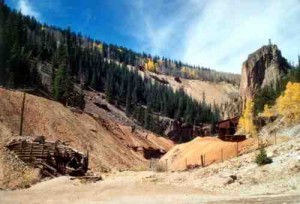Essay by John Mattingly
Agriculture – July 2006 – Colorado Central Magazine
John Mattingly wants you to pay more for food,
and he thinks you should want that, too.
THOUGH FARMERS GET PUBLICITY ranging from hard-working yeomen to subsidy-sucking parasites, the fact is, no one but farmers want farmers to be price makers. The structure of the current U.S. economy boxes the farmer into being a price taker. Consumers like it. They spend only about 10% of their income on food (the lowest percentage in the world), and that enables robust retail consumerism.
But our nation’s foolhardy push for cheaper and cheaper food has been damaging America’s farmland and environment, and it discourages better, more conscientious farming practices. Food and farmland are worth far more than we’ve been paying, but more reasonable prices will require fundamental changes.
I have some positive suggestions, although my first one is somewhat unrealistic: We should spend less on international adventurism and more on domestic realism. We’re spending more in two weeks in Iraq than we spend annually on all domestic farm programs. However, the upcoming mid-term election may start to turn this battleship around.
My second suggestion is more practical. Farmers who grow crops for the perfect markets (corn, cotton, wheat, beans, cattle, etc.) now have access to technology that enables them to be market makers. Farmers have actually had access to this technology for about thirty years, but have been suspicious of it. I’m speaking here of The Futures Markets.
I recall in the Seventies and Eighties many farmers “played the futures” and got burned, or they had a neighbor who did. Thus there was a tendency toward believing that a conspiratorial group of “speculators back East” got up just a little bit earlier in the morning than the farmer and beat him out of his hard-earned bucks.
Today, most farmers understand the Futures Markets as a democratic body that elects a daily price for internationally traded commodities. The Futures Markets are to the Actual Markets what a digital watch is to a sundial. They track the same thing, only by different means. There are several ways a farmer can access the daily price results, but it’s done most easily with the computer and modem now sitting in the corner of most farm shops or offices.
My suggestion as to how farmers use the Futures Markets follows:
(a) The farmer must know his or her actual cost of production. This would include all variable expenses, but also give ledger status to depreciation of the solar collector, the farm, the earth. Most calculations of production costs exclude this line item. It needs to be in the mix, and every farmer’s number will be different. It will take time and thought for each farmer to arrive at a way of figuring it. But it exists, and must be sought and quantified.
(b) At planting time, the farmer looks at the Futures Market price in his or her normal month of harvest. If a price is not offered that represents a true profit — that is, a price that covers variable input costs, depreciation on machinery, and restoration of the solar collector — then the farmer is better off buying his expected production on the Futures Market instead of growing it.
The economic consequence of this is dual upward pressure on the daily vote for price because (a) the farmer is not contributing to the Actuals Market with his production, and (b) buying his expected production on paper is the same as casting a vote for a higher price. And every vote counts in this market.
(c) If, on the other hand, the farmer looks at the Futures Market at planting time and the price offered at his or her normal month of harvest represents a true profit, then he should consider selling a portion of his expected crop at that price.
THIS SUGGESTED STRATEGY allows for each farmer in the United States to individually tailor his or her growing/marketing plan. For example, a grower in the rain-fed country of Kansas may figure that $3.80 a bushel for wheat is a true profit, while an irrigated farmer in eastern Colorado might need $4.50. If, at planting time, the Futures price of wheat is $4.00, the Kansas farmer is prudent to sell the Futures and plant the wheat while the Colorado farmer is prudent to buy the Futures and go fishing. The Kansas farmer locks in a true profit of $.20 a bushel and the Colorado farmer saves $.50 a bushel. This is not “Playing the Futures” This is using the Futures as a tool.
Presently, farmers are using the Futures primarily to schedule the marketing of a crop already grown. They must learn to use the Futures to make the market rather than merely accept it.
But I have three more suggestions at the federal level:
1. Make food stamps redeemable only at bulk food centers, not supermarkets. Food stamps should be for food in its raw, unrefined state. Distribution centers could be established in urban areas and supply a bushel of wheat (60 pounds) for less than the cost of an 8 ounce loaf of bread. The centers could plug into existing Farmer’ Markets and/or provide a financial incentive for their expansion.
It isn’t widely realized that when the agriculture budget is quoted, the number includes the funding for food stamps, which represents about 1/4 of the total. If they are truly food stamps, they should be for food, not preparation, packaging, and placement in a supermarket.
2. Enhance the CRP, Conservation Reserve Program, the successor to the old Soil Bank programs of the Fifties and Sixties, while proportionally reducing commodity price supports. Banking soil is a legitimate function of government. Subsidizing surpluses is not. Much of the farm ground now producing surpluses that necessitate the feeding of confined livestock would be better put in conservation reserve for a time when it is actually needed.
We in the U.S., particularly those of us farming in the arid West, inherited a big bank account of soil fertility. We’ve only been farming it for a couple hundred years at most. If we intend a civilization of centuries, we need to make deposits to the soil bank rather than continuous withdrawals.
3. On the Schedule F, the federal income tax filing form for farms, eliminate accelerated depreciation deductions for purchases of new machinery. Currently, a farmer can depreciate over $100,000 of new machinery purchases in one year. While this is good for the Iron Triangle of machinery manufacturers, lenders, and dealers, it isn’t realistic and distorts the intent of the depreciation allowance.
ORIGINALLY, the depreciation deduction was meant to be matched with a deposit to a savings account. Say a farmer bought a $50,000 tractor that he expected to last 10 years. Each year he would write off $5,000 on his taxes and deposit $5,000 in the bank, so at the end of ten years he would have cash, plus the salvage value of the old unit, to purchase a new one.
It’s safe to assume that in today’s economy, accelerated depreciation is never matched with a bank deposit. Having the accelerated option artificially encourages the purchase of technology that only adds to the farmer’s efficiency, which contributes to surpluses and thus to lower or level commodity prices. And when the farmer sells the fully depreciated machine, his cost basis is now zero and he must pay the recapture, so in the end, taxes have been deferred, not eliminated.
As so often happens when a farmer has a good year, he purchases new, depreciable technology for the express purpose of accessing the accelerated depreciation to avoid taxes. He does so on credit, and when bad years come along, forcing sale of the machine, the tax bite comes as a doubly unpleasant surprise.
Currently no one wants farmers to be price makers, because American consumers and the U.S. economy have long reaped the benefits of cheap food. But we should embrace the idea, because the deferred costs and damages inherent in our current system are mounting. For a better future, American farmers and consumers will need fresh ideas about what constitutes a wholesome Farmers’ Market.


